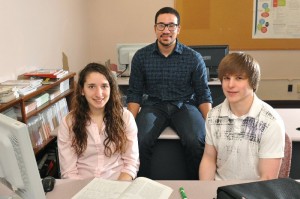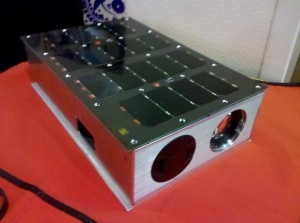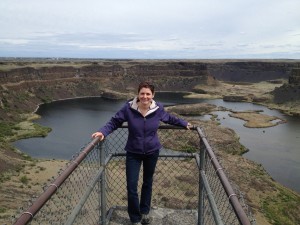
Three SUNY campuses may now tout relations with the world’s leading aerospace engineering organization, NASA.
- SUNY Oswego recently announced that three more undergraduate students will intern this summer in NASA’s Jet Propulsion Laboratory;
- NASA last week announced that it will be launching a satellite into orbit which was designed by students from the University at Buffalo; and
- A Stony Brook University expert this year utilized data from two NASA tools to help Look for Life on Mars.
Read on to learn more about these opportunities and success stories from some of SUNY’s leading astro-researchers, developers, and analysts.
Researchers
 Following the trail blazed by 2012 alumnus Earl Bellinger, three more SUNY Oswego students will rocket into internships this summer at NASA’s Jet Propulsion Laboratory at Caltech, the California Institute of Technology.
Following the trail blazed by 2012 alumnus Earl Bellinger, three more SUNY Oswego students will rocket into internships this summer at NASA’s Jet Propulsion Laboratory at Caltech, the California Institute of Technology.
NASA’s Jet Propulsion Laboratory (JPL) at California Institute of Technology selected three SUNY Oswego seniors for internships this summer for computer programming work on the Cassini satellite mission. From left are Samantha Bielli, majoring in computer science and applied mathematical economics, computer science major Delvison Castillo and software engineering major Andrew Darwin.
JPL selected SUNY Oswego seniors Samantha Bielli, Delvison Castillo and Andrew Darwin to work for 10 weeks on the Cassini satellite mission at the renowned research complex in Pasadena starting this June.
Bellinger, a graduate in computer science and applied mathematics, burned so brightly during his time at JPL in 2012 that a supervisor there asked Oswego physics professor Shashi Kanbur to “send us more” for summer 2013, Kanbur said.
“It will be a fantastic experience for these students to put on their resumes,” Kanbur said. “I think it’s a great thing for the college. Think about their orientation at JPL: ‘Where are you from?’ ‘SUNY Oswego.’ ‘OK, where are you from?’ ‘SUNY Oswego.’ ‘And where are you from?’ ‘SUNY Oswego.’ Where you are from creates an impression.”
Development

40 engineering students at the University at Buffalo have developed a satellite which NASA has agreed to launch. The Glint Analyzing Data Observation Satellite (GLADOS), a shoebox-sized tool, took the research team two years to construct. It is designed to track the size and orbit of debris circling our planet.
GLADOS is funded by a $300,000 grant from the United States Air Force and the team is looking for more capital to finish its production. The project was competing against 33 projects from other universities, private corporations and even NASA’s own projects for a ride into space.
John Crassidis, a professor of mechanical and aerospace engineering at UB, leads the project, which tests his theory that glints of sunlight reflecting off space debris could help determine its size, shape, mass and spin. GLADOS hosts cameras and navigation equipment that will help identify and track the materials. In addition, the spacecraft may also help predict the path of space debris several months in advance—thus avoiding orbital collisions.
[iframe width=”728″ height=”410″ src=”http://www.youtube.com/embed/Av-7KfQ5ARg” frameborder=”0″ allowfullscreen]
Data Analysis
 Recent research has shown that many of the rocks brought up from the Martian subsurface contain clays and minerals whose chemical make-up has been altered by water, an essential element to support life. Some deep craters on Mars also acted as basins where groundwater likely emerged to produce lakes. McLaughlin Crater contains clay and carbonate minerals formed in an ancient lake on Mars. The fluids that formed these minerals could carry clues to as to whether the subsurface contained life.
Recent research has shown that many of the rocks brought up from the Martian subsurface contain clays and minerals whose chemical make-up has been altered by water, an essential element to support life. Some deep craters on Mars also acted as basins where groundwater likely emerged to produce lakes. McLaughlin Crater contains clay and carbonate minerals formed in an ancient lake on Mars. The fluids that formed these minerals could carry clues to as to whether the subsurface contained life.
Stony Brook University geosicences professor Deanne Rogers used data from the Thermal Emission Spectrometer aboard NASA’s Mars Global Surveyor and the Thermal Emission Imaging System aboard the Mars Odyssey orbiter to detect and identify minerals that proved to be consistent with a sustained watery environment on the floor of the McLaughlin Crater. The research suggests that the ingredients for life have been present in the Martian subsurface for much of the planet’s history.
“Our understanding of Mars is changing very rapidly with all of the new mission data,” said Professor Rogers. “There have been several recent observations and models that have pointed to the possibility of a vast store of groundwater in the Martian past, and perhaps present. So you might expect that deep basins such as McLaughlin, which intersect the upwelling groundwater table, would contain evidence of this water. And this study found that evidence.”
This research shows how studies of Earth and Mars depend on each other. Earth’s early geological record is poorly preserved due to plate tectonics. Studying the ancient geological record on Mars would teach a tremendous amount about early chemical processes in the solar system possibly including those that led to life’s origin and early evolution.

